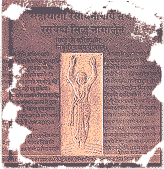 |
Ayurveda,the
oldest system of medicine in the world, traces its roots to the Vedic period in ancient
India. The Vedas contain practical and scientific
information on various subjects beneficial to the humanity like health, philosophy,
engineering, astrology etc. Vedic Brahmans were not only priests performing religious rites and ceremonies, they also became the Vaidyas (Ayurvedic Physicians). The Sage- Physician- Surgeons of that time were the same sages or seers, deeply devoted holy people , who saw health as an integral part of spiritual life. It is said, that they received their training of Ayurveda through direct cognition during meditation. In other words, the knowledge of the use of various methods of healing, prevention, longevity and surgery came through Divine revelation . These revelations were transcribed from the oral tradition into book form, interspersed with the other aspects of life. |
||||||||
| Consequently Ayurveda grew into a respected and widely used system of
healing in India. Around CA.1500 Before.Common era. Ayurveda was delineated into eight specific branches of medicine and there were two main schools - Atreya, the school of physicians, and Dhanvantari , the school of surgeons. These two schools made Ayurveda a more scientifically verifiable and classifiable medical system. People from numerous countries came to Indian Ayurvedic
schools to learn this medical science. |
|||||||||
| The main authentic texts of Ayurveda in its early History are: | |||||||||
 |
Rig
Veda CA.3000 Years Before.Common era. : Verses on the nature of existence , on
nature of health and disease, pathogenesis and principles of treatment. Among the Rig-Veda
are found discussions of the three doshas, Vata, Pitta and Kapha and the use of herbs to
heal the diseases of the mind and body and to foster longevity. Atharva Veda CA.800 Years Before.Common era. : Lists the eight divisions of Ayurveda - Internal Medicine, Surgery of Head and Neck,Opthalmology and Otorinolaryngology, Toxicology, Psychiatry, Paediatrics, Gerontology or Science of Rejuvenation and Science of Fertility Charaka Samhita CA.600 Years Before.Common era.: A major work on internal medicine , written by the physician Agnivesa, modified by charaka Sushrutha Samhita CA.500 Years Before.Common era. : Sushrutha , a surgeon who developed the operative techniques of rhinoplasty (plastic surgery), wrote the Sushrutha Samhita which describes a highly developed surgery. Samhitas of Vagbhata CA.600 Years A.D. : This text deals with all aspects of life, health, disease and treatment. |
||||||||
It is because these texts contain the original and comlete knowledge of life, Ayurveda is known today as the only complete medical system still in existence. |
|||||||||
|
The roots of Ayurveda Principles of Ayurveda Diseases and Cures Health Promotion and Preventive Care The Purification Therapies Philosophy & Yoga Ageing and Rejuvenation Women and Child Care |
|||||||||
